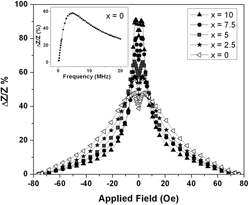No CrossRef data available.
Article contents
Effect of replacing B by Zr in amorphous Co-Fe-Si-B soft magnetic alloys
Published online by Cambridge University Press: 12 March 2012
Abstract

Amorphous ribbons of Co69Fe7Si14B10-xZrx (x = 0, 2.5, 5, 7.5 and 10) alloys have been prepared and their structure, soft magnetic and magnetoimpedance (MI) properties have been investigated. Glass forming ability (GFA) of these alloys was calculated using GFA parameter (α = Tx/Tl) and verified by experimental results. Saturation magnetization of the amorphous ribbon decreases on replacement of B by Zr which reveals Zr has more pronounced effect in decreasing saturation magnetization. However, improvement of other soft magnetic properties (coercivity and permeability) leads to considerable increase in MI properties. Annealing leads to crystallization of Co2Si, Co2B, Co2Zr and CoSi phases causing deterioration of soft magnetic and MI properties due to the magnetic hardness of the secondary phase which arises due to the presence of magnetocrystalline anisotropy.
- Type
- Articles
- Information
- Copyright
- Copyright © Materials Research Society 2012




